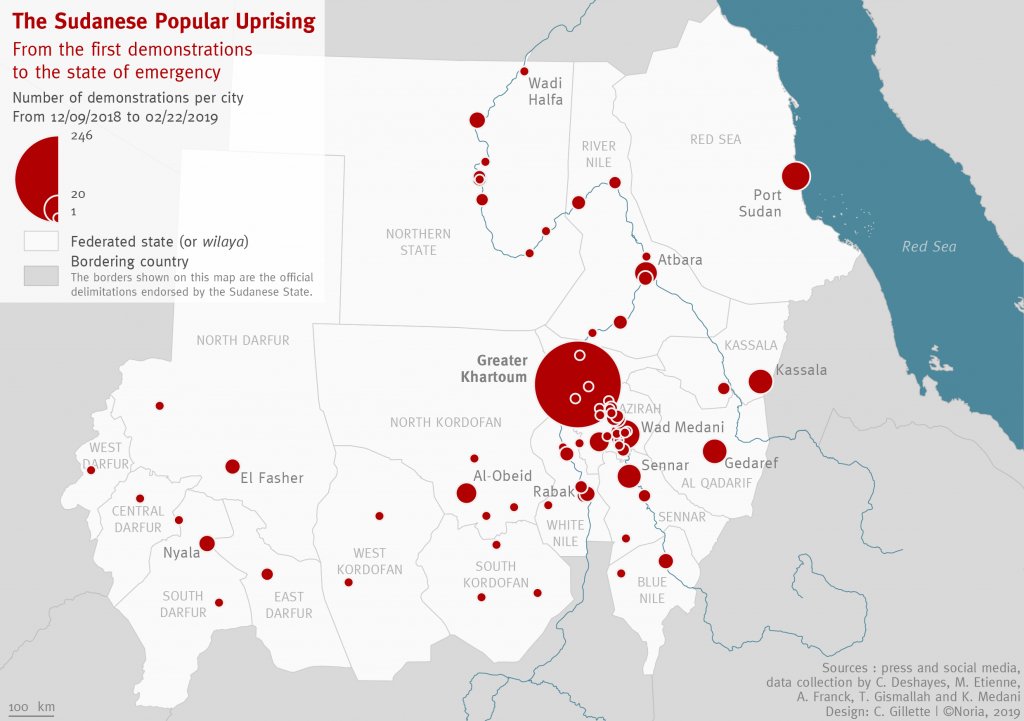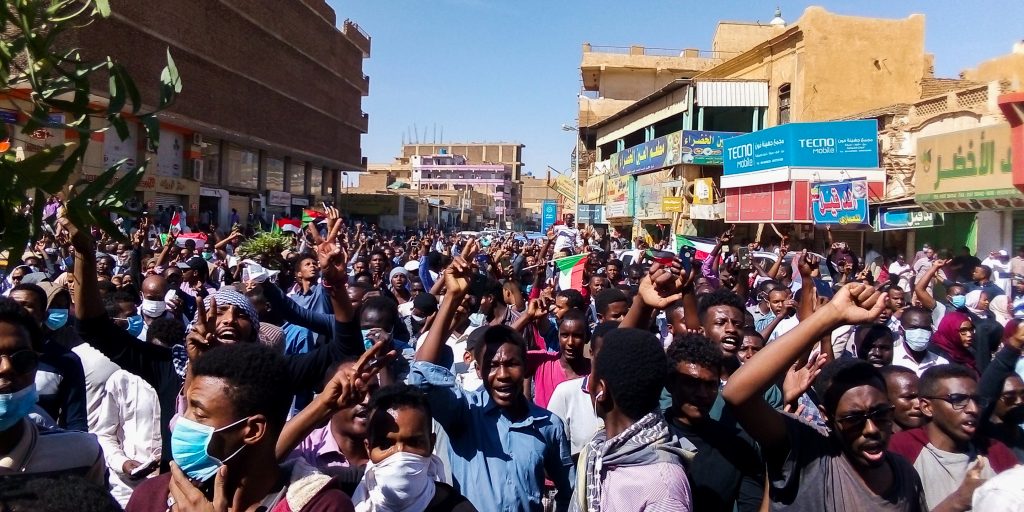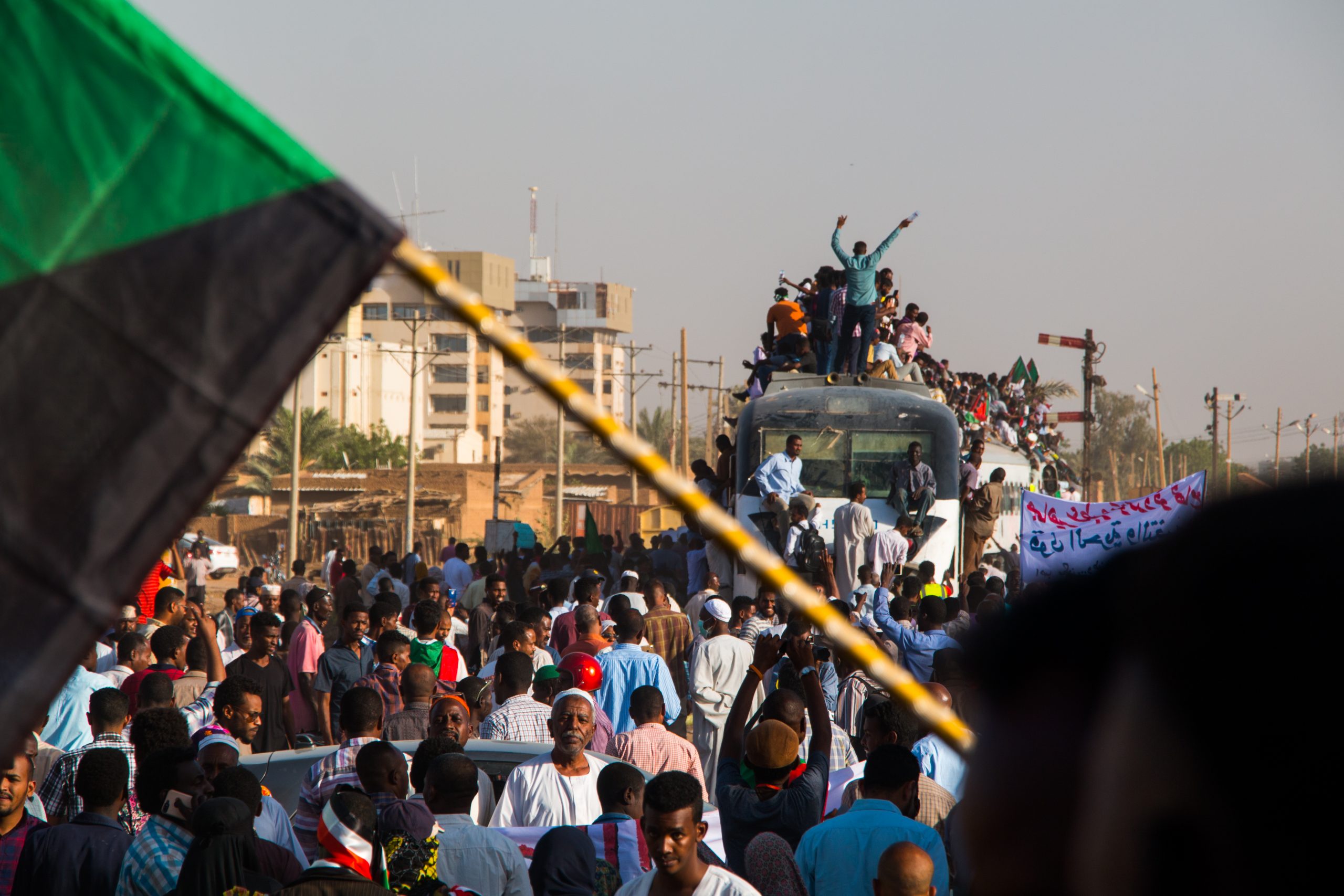Who are these people who went to the streets? For these last two months, do we notice an evolution in the profile of the protesters? What kind of differences could we see between the capital and the provincial cities looking at both the demonstrations and the protesters?
Magdi El Gizouli: While this is in many ways a troubling question to ask in these times of enthusiasm it is an important one. My understanding is that, there is a certain evolution and there are differences to register. The current wave protests first began in Atbara, a dusty town on the Nile, located 350 kilometres north of Khartoum.
An understanding of the background might help explain the social composition and the behaviour of the Atbara protesters on 18 and 19 December last year, the initial spark of the current wave of demonstrations. The Atbara protests were an immediate popular response to the tripling of bread prices in Atbara after a government decision to slash wheat subsidies (i.e. a decision taken on the advice of the IMF).
Through this policy, the government was clearly testing the limits of the people to know what is seen as tolerable or not by the inhabitants of Atbara. As a consequence, the protesters of Atbara were the poor bread buyers of the town: teenage students from Atbara’s industrial school, artisan miners in a frontier town of a gold rush, day labourers from the Atbara marketplace and migrant students of Atbara’s River Nile University. They directed their anger at recognisable symbols of power and privilege in Atbara. They set the headquarters of the ruling National Congress Party (NCP) on fire, burnt parked cars in the vicinity and ransacked ATM machines.
“Among the workers of Atbara Sudan’s communists discovered the ‘people’ and a working-class nationalism took root as opposed to the elite nationalism.”
In fact, far from being an undistinguished town, Atbara has a strong labour militancy and emancipatory memory. It is also a creature of colonial dominance. It came to be thanks to imperial design. The town is a byproduct of the railway line that the incoming army of Anglo-Egyptian occupation constructed to effectively transport troops up the Nile to defeat the Mahdist state.
Atbara developed into the capital of Sudan’s railways and became a cradle of Sudan’s modernity. The first stirrings of labour union in Atbara date back to the 1920s. Atbara was an experiment in city making. It attracted landless peasants and emancipated slaves seeking employment in the new sphere of labour. It was these pioneers of the emerging wage-economy who formed the vanguard of Sudan’s working class. Among the workers of Atbara Sudan’s communists discovered the ‘people’ and it was among the workers of Atbara that a working-class nationalism took root as opposed to the elite nationalism of the effendiya.1 The heritage of working class organisation and militancy is truly Atbara’s gift to Sudan.
It was in Atbara that the Sudanese working class discovered the ‘trade union’ and it was a momentous discovery indeed. The solidarity within the trade union was a revolutionary social relationship that has challenged and often successfully supplanted the bonds of ethnicity, race and even gender. Sudan’s successive dictators, Abboud (1958-1964), Nimayri (1969-1985) and al-Bashir (1989-2019), all considered Atbara as a threat: a place where the racist ideology of Sudan’s ruling establishment was denounced and often defeated. Atbara became a citizenship and a label for its people, referred as Atbarawis irrespective of their ethnic or tribal origins.
It was under Nimayri that Sudan Railways were starved of funding and Atbara workers laid off in droves. The decisive blow came however when Nimayri prioritised motorised transport of goods on highways over the railways in collusion with a number of Sudan’s business magnates. More layoffs and the eventual privatisation of the railways followed under al-Bashir. Atbara is a place to meet the losers of Sudan’s neoliberal transformation in heartland Sudan.
Thanks to Sudan’s gold rush, Atbara witnessed a recent economic boom after 2010. It now attracts artisanal miners from all around the country, mostly impoverished peasants and urban poor, who use it as recovery plant and sales point. Unlike the railway workers, these are self-employed small producers often locked into deadly competition with mining firms still in the exploratory stages of their enterprises. Some will eventually be forced to sell their labour force to these bigger companies if and when gold mining on an industrial scale proves profitable for the foreign investors.
What about the spread of contest from Atbara to the entire country?
The bravado of Atbara’s protesters proved immediately contagious. In Gedaref, the capital of Sudan’s commercial agriculture and a centre for seasonal agricultural labour, subaltern protesters went on the streets mimicking what they have seen and heard from Atbara. They burnt the NCP headquarters, attempted to storm the local government headquarters and forcibly opened the storehouses of the Zakat chamber2 for spontaneous mass distribution. Similar scenes were repeated in al-Rahad and al-Nuhud in Kordofan, both centres of agricultural trade. Up to this point, the mass of protesters were drawn from poor town dwellers and from people who have lost out in the reworking of land relations in rural Sudan to the benefit of commercial agriculture.

It was at this juncture that the government used its racist ideology to dismiss the protests as violent deeds of criminal elements. The chief of the National Intelligence and Security Service (NISS) accused Darfuri student supporters of Abd al-Wahid al-Nur, the Paris-based leader of the rebel Sudan Liberation Army/Movement of responsibility for the violence. Darfuri students were rounded up at gun point from their houses in Sennar and Khartoum and paraded in front of television cameras with bunches of mobile phones, laptops and light weapons to demonstrate their crimes. They disappeared in the detention centres of the NISS without much of a trace. It was also in Atbara and Gedaref that the response of the security services was particularly violent and bloody. When facing subaltern elements the security services exercised no restrain in shooting. Since life has a political price tag to it, life of seasonal labourer from Darfur in Gedaref’s was not especially valued. When the Khartoum activists celebrate the martyrs of the revolution, those killed in Gedaref feature as a number.
In Khartoum, the picture was certainly different. The protests were dominated by the middle classes, mostly young professionals and university students, and were indeed non-violent. There was often a carnivalesque atmosphere, amplified by the power of social media. Young women and men competed in documenting their involvement through Facebook livestreams and a flurry of pictures taken with their smartphones and internet-connected cameras. The subalterns of Khartoum were marginally discernible, only emerging in the protests within districts like Khartoum’s Kalakla and Omdurman’s Um Badda.
“Al-Bashir was being punished for failing to deliver, his ability to deliver benefits to the middle class of Khartoum was grounded in the violent expropriation and deprivation of Sudan’s hinterlands.”
The epicentre of protests was in Burri, a predominantly middle class neighbourhood. Here young women and men were in a way living out new subjectivities of insubordination and revolt against the government, and more importantly against a patriarchal moral order. In this light, the bulk of protesters in many locations were young women. The NISS chief said 70%, but the exact figure is not important. The young women on the streets were demonstrating corporeal presence, agency and discontent with the gender architecture of the city.
That said, it is worthwhile wondering about the freedoms that the middle class protesters pursue. On one hand it is indeed the freedom from tyranny, from political oppression, the freedom of expression. It is also, I presume, the freedom to consume, the freedom of the individual aspirant in a socioeconomic field structured by the interests of commercial capital, the freedom to win. The anger of the Khartoum protesters was directed against a tyrannical political system, and mostly against the person of al-Bashir, the dictator and his cronies.
People rose up against the lack of benefits but not necessarily against the structures of power and privileges that create and condition these benefits. Al-Bashir was being punished for failing to deliver, but little attention was paid to the fact that his ability to deliver benefits to the middle class of Khartoum was grounded in the violent expropriation and deprivation of Sudan’s hinterlands. Khartoum’s middle class might consider terrible the violent processes of primitive accumulation in Darfur for instance, yet without these processes their quality of life would be impossible.
A new organization that brings together liberal professional associations (doctors, lawyers …), the SPA, seems to take the lead of the current social movement. Who are they and what does this alliance really represent both sociologically and in the Sudanese trade union landscape? What is the strategy of this new organization?
The mystery of the SPA is a façade; it is simply an umbrella formation of associations that emerged out of the wasteland of Sudanese politics in the past 20 years or so. Its core is composed of three bodies of professionals: the Sudanese Doctors Central Committee, a strike action committee that successfully led a doctors’ strike back in 2016; the Sudanese Journalists Network, formed in 2008 as an alternative to the government-aligned Sudanese Journalists Union; and the Democratic Lawyers Alliance, essentially an electoral list of opposition lawyers who have repeatedly attempted to win the elections of the Sudanese Bar Union.
The SPA announced its existence in August 2018 at a press conference during which it unveiled a study on the minimum wage. Their original intent was to submit the study together with a list of demands to Parliament in a demonstration of professionals. The turn of events in December 2018 pushed them to adopt a new strategy. So they drafted a declaration dubbed the ‘Freedom and Change Declaration’ demanding the immediate resignation of President al-Bashir and his government and the formation of a ‘Transitional National Government’ composed of ‘technocrats’.
But now, this formulation: the removal of a sovereign and the idea of ‘technocrats’ governing for a period of transition is the standard codification of a ‘coup’. The decisive act of overthrowing the dictator is outsourced to a military officer who is supposed to align the military with the interests of the protest movement, now understood as a the agent of popular will.
And what parallel can be drawn between this association SPA and the role of trade unions in the revolutions of 1964 and 1985?
Indeed, the SPA has ancestors, known as the Syndicates Front of 1964 and the Trade Unions Alliance of 1985. Both emerged in the midst of mass political mobilization to claim a leadership role as representative of middle-class professionals, without having to rely on powerful allies. The Syndicates Front, at a time of leftist ideological domination, considered itself as a vanguard made of radical petty bourgeoisie. It had militant allies from the working class and the organised peasantry, namely the Sudan Trade Unions Federation and the Farmers Union, both having communist leadership. Accordingly, the Syndicates Front could indeed muscle power and constitute the transitional government after October 1964; a worker and farmer actually occupied ministerial positions to the dismay of the Sudanese establishment.

However, the patrician parties3 made a spectacular come back within a year. It is during this period that we witnessed the first proposals for a powerful presidency, an Islamic constitution and a religious State that finally became the agenda of counter-revolution in Sudan. The constituents of the Syndicates Front, demoralised and excluded from power by the patrician parties, would look into another direction the next time. Their leaders actively plotted with likeminded military officers to achieve the 1969 coup that brought Jaafar Nimayri to power. Nimayri was their sovereign, their claim was that May 1969 was the continuation of October 1964.
In comparison, the 1985 Trade Unions Alliance was far weaker; it was already defeated when Nimayri’s officers ousted the man in the palace coup led by General Siwar al-Dahab. The Islamic Movement had by the time gone a long way in displacing the old elite and becoming the new reliable ally for the military. This time it was the Islamist professionals who were the vanguard of the petty bourgeoisie.
What do we learn from this record? Associations of professionals emerge in moments of revolutionary crisis, their politics is always oscillating between alliance with popular classes and reliance on the military as a way to secure power. Their political instincts favour change from above and their proposal of a transitional government dissimulates putschist inclinations usually popularised under the slogan of the army siding with the people.
In this light the distinction between Islamist and secular groups is arguably secondary since both factions of the middle class have followed similar political strategies in capturing the state: both had their Bonaparte, the secularists their Nimayri and the Islamists their al-Bashir. In relation to country’s economy, the convergence is also apparent and embodied by two figures: Nimayri’s finance minister Badr al-Din Suleiman and al-Bashir’s finance minister Abd al-Rahim Hamdi. Badr al-Din was the secular bureaucrat who implemented the IMF’s 1978 recovery programme encompassing currency devaluation, austerity measures, liberalisation of trade and privatisation of public assets. Abd al-Rahim was the Islamist financier who masterminded the 1990s neoliberal assault with identical features.
Can we analyse this revolt as a movement coming from the middle class and salaried classes? Can we speak of an alliance between: a middle class which emerge in the 60s and 70s with a first development (mainly inherited from the British) of the State and the university of Khartoum; and a new middle class that has been produced by education and economic policies of the current regime?
At the current juncture, it is predominantly a revolt of the salaried classes, and the SPA arguably operates as their political voice. The expansion of privatised higher education in Sudan under this government is a powerful factor. It was interesting to watch students at Sudan’s most prestigious private institutions of higher education, Mamoun Himmeida’s University of Medical Sciences and Technology (UMST) engaging in protests and strikes against the government. For a moment there, the sophisticated daughters and sons of the most privileged families were lined up facing rustic policemen of mostly subaltern extraction.
In a way, the Islamic Movement through its restructuring of the economy in favour of commercial enterprises engendered an expansion of the urban middle classes who no longer share its ideological trappings. Once an engine for the interests of a provincial educated elite, it is today a shackle on the aspirations of urbanite cosmopolitans who, like the Islamists of yesteryear, want a nation crafted according to their self-image.
It is interesting in this regard to notice that the themes of SPA’s propaganda are drawn to a great extent from the literary tradition of the Graduates Congress, Sudan’s first organ of the educated elite and the erstwhile bearer of effendiya nationalism. To my mind, this vintage patriotism, resuscitated from a glorified era of perceived political innocence that predates the fractures of party politics, regional dissent and civil war, serves to obfuscate social conflict and to reimagine the nation as an organic whole undented by difference.
To add on that, it appears that a part of the middle class, possessing a strong school capital and an important symbolic capital (family and historical prestige) has historically often demanded the conduct of public affairs. How was this claim built? Is the SPA the last avatar representing this “traditional” urban elite?
Obviously, the continuities you mentioned are important. Many of today’s liberal-minded activists are the heirs of the effendiya in the immediate sense of family and social capital. In the same way, the SPA is probably better understood by comparison to the Graduates Congress of the 1940s, an organisation conditioned by their vantage point from Khartoum’s schools and clubhouses where a Kordofanian peasant or a Darfuri seasonal labourer might be invited to clap and cheer but not to join the conversation nor to share the table. When they did consider the ‘people’ they wanted to govern, the effendiya of the Graduates Congress sought and nourished the authority of the patricians. This might demonstrate the importance of the Atbara bond I talked about earlier: trade unions generated the idea of rightful citizenship as opposed to the clientelism of the patricians.
Notes
- The effendiya (sg. effendi, Turk.): educated bureaucrats. The term was used by British officials during the Anglo-Egyptian condominium to refer to the new class of educated Sudanese civil servants. ↩︎
- Zakat is a Muslim religious obligation and constitutes an annual tax of around 2.5% on wealth. A government-managed Zakat Fund was established in Sudan in 1980 on a voluntary basis. Zakat was made compulsory in 1984 with the establishment of the Zakat Chamber and further formalised with the Zakat Act of 1990. ↩︎
- Reference is here to the Umma and Nationalist Unionist parties, the political arms of the Ansar and Khatmiyya religious orders led by the Mahdi and the Mirghani families respectively. ↩︎

